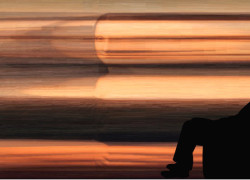
Words by Brooke Munday
Melbourne-based Arie Rain Glorie loves his work. It’s clear the moment he starts speaking, as the excitement bubbles through. “Just like a sculptor might work with clay or a painter works with oil paints—I’m interested in exhibition in the same way. It’s my material,” Glorie says.
As the curator of Melbourne Fringe exhibition, Carousel, Glorie set out to change his audience’s experience of art; to force them to pay attention and enjoy artworks under more intense conditions.
“What we’re finding is that people are only looking at visual artworks for fifteen seconds on average before they move on to the next work.” A statistic, Glorie says, that drove his desire to create something uniquely engaging.
Glorie’s fourth major curatorial exhibition, Carousel is an amalgamation of the experience of theatre and the attractions of a gallery. It forces the audience to sit down and pay attention to an art piece for an entire minute, giving them the opportunity to properly take it in.
“It’s kind of such a nuts idea that it just might work,” Glorie says. “What we’re doing is installing a revolving stage into our exhibition space and the audience will actually sit down like it’s a theatre show. We literally bring the artworks to you on this carousel system.”
Art galleries traditionally require audiences to move from piece to piece of their own accord, often across multiple floors. When Glorie set out to create Carousel, he wanted to tackle this issue. “The thing I’m realising working through this process is that through [Carousel’s] unique structure, it is actually quite accessible for people who can’t do that.
“The structure—exhibition practice—has only been around for about 200 years, yet we assume that it’s as old as the Ancient Greek theatre,
“We assume that walking into a white cube is just the way it should be done but there are so many other ways that are yet to be tapped into.
“[Carousel] is really acting as a kind of prototype of the alternative,” Glorie says.
More than fifty artworks were selected for the show with no specific curatorial theme in mind. However Glorie says that the pieces themselves are “semiotic” in nature.
“What I want people to take away is more thought about what we take for granted and what we just assume is the only way to do it,” Glorie says. “At the heart of it is trying to make visual art an event again.”

